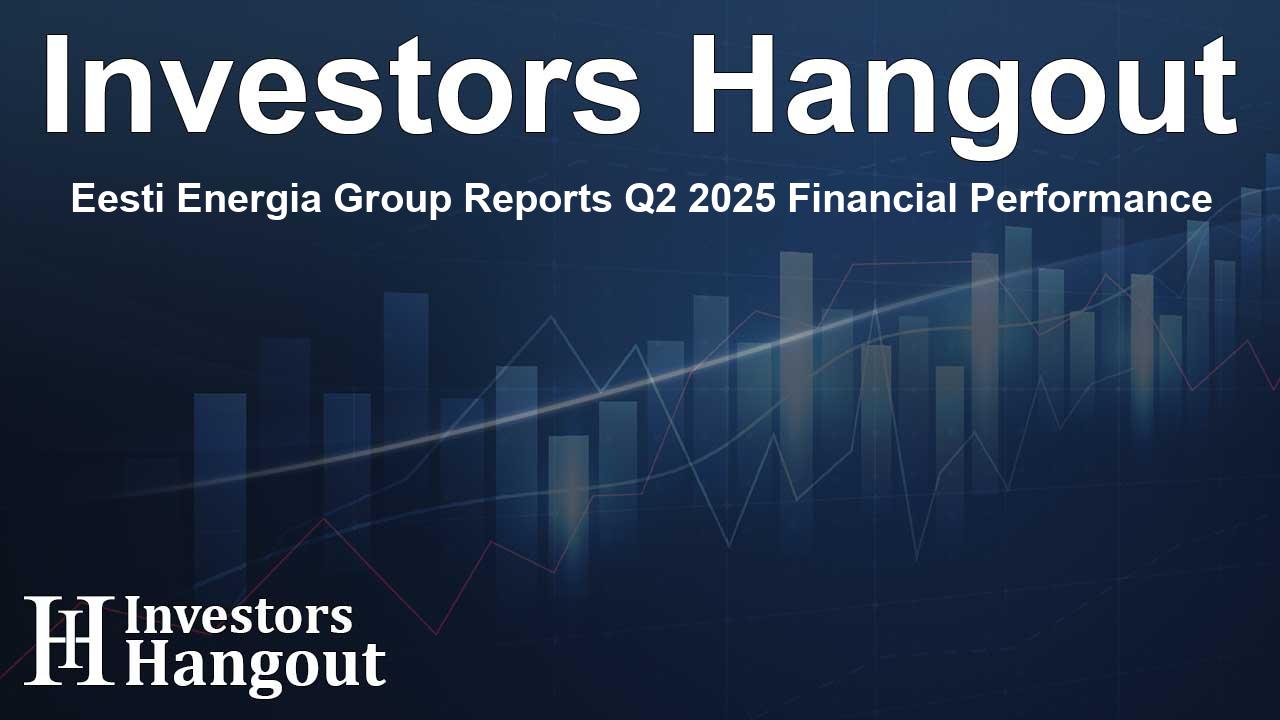Eesti Energia Group Reports Q2 2025 Financial Performance

Sales Revenues and Profitability Overview
In the midst of a challenging energy landscape characterized by fluctuating electricity and oil prices, Eesti Energia Group experienced sales revenue of EUR 388 million in the second quarter of 2025. The EBITDA for the quarter saw a decline, totaling EUR 80 million, while the adjusted EBITDA stood at EUR 83 million. The net profit for the second quarter was reported at EUR 30 million, with an adjusted net profit amounting to EUR 33 million.
The group's performance during this quarter was significantly impacted by the downtrend in shale oil and electricity prices. Currently, Baltic energy prices have reverted to the levels observed before the energy crisis that began in 2022. Comparatively, the previous year's quarter benefitted from one-off gains linked to CO?-related revenues, which bolstered its financial standing. In contrast, the current quarter reflects a normalization, leading to a dip in profitability. Interestingly, within the 'Other' segment, particularly frequency services, strong revenue and EBITDA growth was noted.
*The adjusted EBITDA and adjusted net profit figures are adjusted to exclude temporary fluctuations related to the fair value of long-term Power Purchase Agreement (PPA) derivatives, allowing for improved period-to-period comparisons.
Insights from CFO Marlen Tamm
“The financial outcomes from this quarter have been largely dictated by the shifts observed in the energy market. With the new wind and solar parks that have been developed over the past year, we have successfully generated more renewable energy compared to the previous year. This increase in renewable energy output aids in lowering electricity prices and easing the financial burden on consumers,” remarked CFO Marlen Tamm.
“However, the drop in market prices equates to diminished revenues for energy companies, ultimately constraining future investment opportunities such as expanding new generation capacities. This pervasive trend of low prices and heightened price volatility seems to be establishing a new norm in the energy sector, a situation we anticipate continuing in the coming years.”
“To navigate these evolving dynamics, it is crucial for energy corporations to adapt. Hence, Eesti Energia has proactively initiated measures to form an integrated energy group that combines renewable energy, dispatchable generation, battery solutions, and a comprehensive customer portfolio, thereby fortifying our competitive edge.”
Renewable Generation and Electricity Sales Segment Review
Sales revenue from the renewable generation and electricity sales segment witnessed a year-over-year decrease of 26%, totaling EUR 170 million. Conversely, however, renewable electricity production surged by 27%, reaching 0.6 TWh, spurred by the establishment of new wind farms like the Sopi-Tootsi facility, which adds 255 MW of capacity over the prior year. On the downside, retail electricity sales volumes fell by 7%, amounting to 2.1 TWh.
Segment EBITDA took a 64% hit, dropping down to EUR 13 million, primarily due to lower sales prices (contributing a decline of EUR 29.9 million), which was partly a result of a 20% decrease in the average price in the Nord Pool Estonia area compared to the previous year. The impact was also felt from reduced sales volumes (contributing EUR 7.4 million to the drop). Meanwhile, decreased electricity purchasing costs provided some offset with an improvement of EUR 17.8 million.
Performance of Non-Renewable Electricity Production
On the non-renewable electricity side, sales revenue saw an uptick of 6% year-on-year, reaching EUR 37.1 million. Notably, generation experienced a 2% increase to 0.3 TWh, largely attributed to the ongoing outage of the EstLink2 transmission cable, which necessitated an increase in domestic generation due to the damage incurred in December 2024, affecting around 650 MW of transmission capacity. Fortunately, the cable was reconnected in late June.
Despite this revenue increase, segment EBITDA regressed by EUR 18 million, driven by elevated CO? costs (declining by EUR 8.3 million), increased fixed operational costs (amounting to EUR 4 million), and reduced derivative gains (lowering by EUR 5.3 million).
The significance of fossil-based generation facilities remains as they provide crucial power generation and frequency services. Presently, Estonia lacks a designated compensation paradigm for preserving strategic reserve power services, which has led Eesti Energia to offer this functionality at no cost. However, a new regulation set to take effect from January 1, 2026, will facilitate the Transmission System Operator (TSO), Elering, in procuring reserves to ensure energy security for the region, resulting in a forthcoming revenue avenue.
Distribution Segment Analysis
The distribution segment reported a sales revenue growth of 9%, totaling EUR 73.7 million, supported by higher tariffs and a 2% rise in distributed volumes. Notably, network losses and planned outages experienced a reduction, while unplanned outages remained consistently low.
In terms of EBITDA, this segment saw a robust growth of 35% compared to the previous year. The margin impact positively contributed an increase of EUR 5.1 million, driven by elevated average sales prices and reduced variable costs. The increase in distributed volumes accounted for an additional EUR 0.8 million, while deferrals in maintenance significantly led to a EUR 1.4 million reduction in fixed costs.
Shale Oil Segment Performance
In the shale oil segment, sales revenue decreased by 17% to EUR 43 million, predominantly due to a 15% decline in sales volumes and a 20% drop in average sale prices (excluding derivatives). However, including derivative gains, the average realized price stood at EUR 405.5 per tonne, a modest decline of 3% year-on-year. This performance underscores the effectiveness of the Group’s adjusted hedging strategy, favoring financial options over swaps, which offers downside protection with the potential for upside, especially for commodities mainly trading in backwardation.
Shale oil production saw a total of 103 thousand tonnes, reflecting a 7% decrease. Segment EBITDA dwindled by EUR 64 million largely due to the one-time benefit recorded in the previous year's quarter involving EUR 64.5 million in free CO? allowances, which did not reoccur this year. Excluding this impact, lower prices affected EBITDA by EUR 9.6 million and reduced volumes contributed EUR 5.7 million. However, derivative gains brought a positive addition of EUR 10 million, reflecting the favorable impact of the revised hedging strategy.
Other Products and Services Revenue Growth
In a remarkable turnaround, revenue from other products and services nearly doubled year-over-year, soaring by 97% to reach EUR 32 million, primarily fueled by frequency services. Following the Baltic region's disconnection from the Russian grid, new frequency markets emerged, demonstrating significant price volatility during the initial months. However, Eesti Energia was aptly prepared, featuring both battery and generation assets, which enabled the company to achieve substantial profitability. Frequency services contributed EUR 27 million in revenue and EUR 31.3 million in EBITDA. Alongside, heat and gas revenues experienced moderate growth, while natural gas EBITDA faced a decline of EUR 2.3 million. Overall, segment EBITDA witnessed an impressive rise of EUR 23 million.
As we look forward, there are expectations for frequency services to normalize due to the newly established market dynamics in Baltic frequency markets. While this area remains promising and profitable, anticipated returns may likely be more tempered compared to Q2 2025.
Investment Overview
The Group's capital expenditure totaled EUR 120 million during Q2 2025, marking a notable decrease of 43% year-on-year. A significant portion, approximately EUR 51.3 million, was allocated to near-completion renewable energy projects, particularly the Kelme wind farm in Lithuania, expected to commence production in the fourth quarter of 2025. Furthermore, investments aimed at bolstering the electricity distribution network increased by 7%, reaching EUR 40.2 million, with a focus on minimizing outage risks and enhancing network resiliency against various weather challenges. Investments in the Enefit-280 shale oil plant totaled EUR 13.8 million as the project advances into its final construction phase.
Financing and Liquidity Snapshot
As of June 30, 2025, Eesti Energia holds EUR 619 million in liquid assets, presenting a total available liquidity of EUR 1,019 million, which includes EUR 400 million from undrawn credit lines. The total debt stands at EUR 1,731 million, with a net debt of EUR 1,113 million, showcasing a decrease of EUR 271 million from the prior year.
Notable financing developments throughout the quarter include:
- In April, Eesti Energia acquired around 20% of publicly traded Enefit Green AS shares through a voluntary takeover bid, increasing total ownership to 97.2%. A mandatory takeover is scheduled for early August, after which Eesti Energia will come to hold 100% of Enefit Green AS shares. Consequently, the shares will be delisted shortly thereafter.
- A capital injection of EUR 100 million from the Government in May.
- Issuance of a EUR 50 million senior unsecured bond listed on Nasdaq Baltic in June.
- In July, Fitch Ratings assigned Eesti Energia a first-time long-term issuer default rating of BBB- with a stable outlook.
Current credit ratings:
- Fitch: BBB-, Outlook: Stable
- Moody’s: Baa3, Outlook: Negative
- S&P: BB+, Outlook: Negative
Management’s Outlook
Looking ahead, management anticipates that the full-year 2025 sales revenue and EBITDA will approximately align with 2024 results, whereas capital expenditure is expected to decrease. The Group continues to focus strategically on completing critical projects, such as new renewable energy parks and the Enefit-280-2 shale oil facility, along with ongoing enhancements to the electricity distribution network.
Frequently Asked Questions
What was Eesti Energia's sales revenue for Q2 2025?
Eesti Energia reported sales revenue of EUR 388 million for the second quarter of 2025.
How did the EBITDA of Eesti Energia change in Q2 2025?
The group experienced an EBITDA decline to EUR 80 million during the second quarter, with adjusted EBITDA reported at EUR 83 million.
What drove the performance in the renewable electricity segment?
The renewable electricity production rose by 27% to 0.6 TWh, bolstered by new wind farm developments as the segment adjusted to market price variations.
What were the notable financing developments for Eesti Energia in Q2 2025?
Key developments included a purchase of a significant stake in Enefit Green AS and a EUR 100 million equity injection from the Government of Estonia.
What is the outlook for Eesti Energia regarding capital expenditure in 2025?
The capital expenditure is projected to decline as management focuses on finalizing key renewable energy and distribution projects.
About The Author
Contact Evelyn Baker privately here. Or send an email with ATTN: Evelyn Baker as the subject to contact@investorshangout.com.
About Investors Hangout
Investors Hangout is a leading online stock forum for financial discussion and learning, offering a wide range of free tools and resources. It draws in traders of all levels, who exchange market knowledge, investigate trading tactics, and keep an eye on industry developments in real time. Featuring financial articles, stock message boards, quotes, charts, company profiles, and live news updates. Through cooperative learning and a wealth of informational resources, it helps users from novices creating their first portfolios to experts honing their techniques. Join Investors Hangout today: https://investorshangout.com/
The content of this article is based on factual, publicly available information and does not represent legal, financial, or investment advice. Investors Hangout does not offer financial advice, and the author is not a licensed financial advisor. Consult a qualified advisor before making any financial or investment decisions based on this article. This article should not be considered advice to purchase, sell, or hold any securities or other investments. If any of the material provided here is inaccurate, please contact us for corrections.
